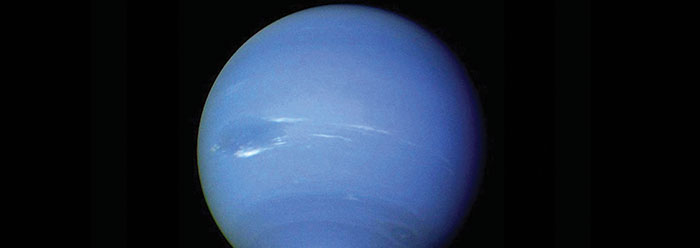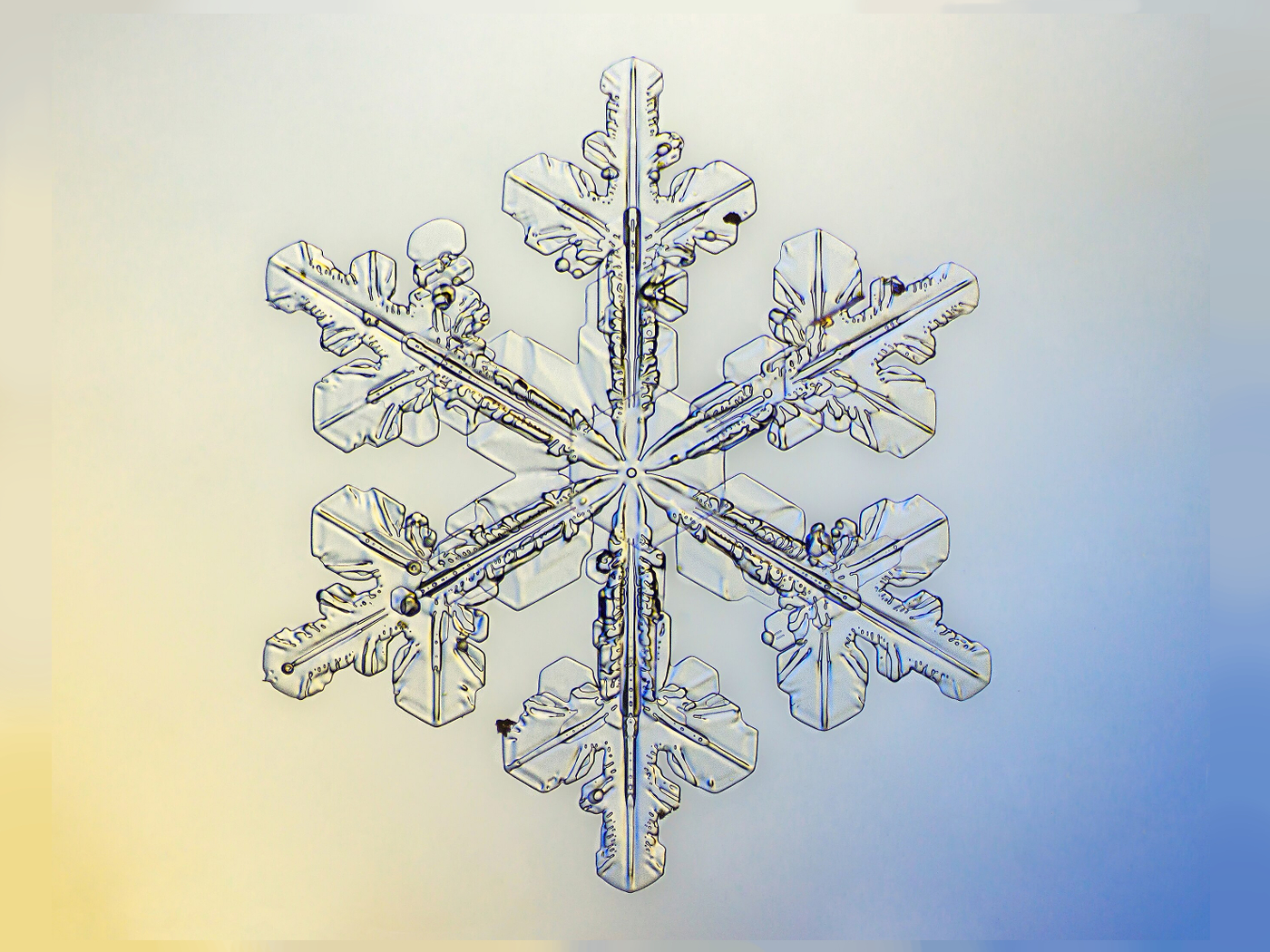The year was 1989. A small, unmanned space probe rapidly approached the mysterious and unexplored planet Neptune. Launched in 1977, the Voyager 2 spacecraft had already visited Jupiter, Saturn, and Uranus, imaging each of these beautiful worlds in unprecedented detail. A rare alignment of the outer four planets made this Planetary Grand Tour possible as NASA scientists were able to use the gravity of each planet to “slingshot” the craft outward to the next world.1 Voyager 2 had traveled over four billion miles during its 12-year mission and was about to become the only spacecraft to visit distant Neptune. This encounter would mark the end of an era of planetary space exploration since Neptune was the one remaining planet unvisited by space probes.2 Astronomers all over the world waited eagerly for the first high-resolution images. What wonderful secrets would be revealed?
A Triumph of Newtonian Physics
Neptune is the only planet in our solar system that was known to exist before it was visually discovered. The counterintuitive story begins with the creation scientist Sir Isaac Newton, who formulated the laws of motion and gravity in the latter half of the 17th century. Newton mathematically demonstrated that the motion of planets could be explained by the sun’s force of gravity deflecting their momentum into an elliptical path. This accounted for Kepler’s laws.3 But it also allowed astronomers to refine their calculations of planetary orbits to include the gravitational influence of other planets—something Kepler’s laws simply could not do. The new physics worked perfectly, correctly predicting the precise position for every planet…except Uranus.
By 1845, the planet Uranus had traversed three quarters of its orbit around the sun since its discovery in 1781, so its path was well known. Its orbital motion nearly matched the mathematical predictions from Newton’s laws. But it was not a perfect fit even when the gravitational perturbations of the other known planets were included. What was going on? Were Newton’s laws incorrect at such extreme distance? Or was there another planet—an unknown planet—pulling on Uranus?
Urbain Le Verrier, a French mathematician, began considering the latter possibility. After many months of intense calculations, he mathematically computed the position that the unknown planet must have in order to explain the discrepancies in the orbit of Uranus. Le Verrier mailed his findings to Johann Galle of the Berlin Observatory. Galle received the letter on September 23, 1846, and, with the help of Heinrich d’Arrest, visually located Neptune that very evening. The new planet was within one degree of the position predicted by Le Verrier. This remarkable achievement led physicist Francois Arago to refer to Le Verrier as the man who “discovered a planet with the point of his pen.”4
Some people suggested naming this new world “Le Verrier’s planet.” But, William Herschel’s failed attempt to name Uranus after King George III had established that planets may not be named after people—at least not directly. Le Verrier insisted that he had the right to name the new planet. Following traditional nomenclature, he christened the new world “Neptune” after the Roman god of the sea. The name fits the sea-blue color of the planet and indirectly pays homage to Isaac Newton by sharing the first two letters of his name.
Properties
At an average solar distance of 2.8 billion miles (over 30 times farther out than Earth), Neptune is the most distant planet of the solar system.5 This makes it a difficult world to study. It is too faint to be seen with the unaided eye under any circumstances but can be detected in binoculars and is easily visible in a backyard telescope. In fact, it is likely that Galileo saw Neptune hundreds of years before its official discovery. This was purely by accident during one of his routine observations of Jupiter. On January 4, 1613, Jupiter passed directly in front of Neptune for several hours.6 While Galileo’s telescope was meager by today’s standards, Neptune would certainly have been visible for many nights before and after this event, though it would have been indistinguishable from background stars. Today, Neptune appears as a tiny, solid-blue sphere in even the most powerful Earth-based telescopes. Atmospheric features, such as white clouds, are occasionally visible—but just barely.
Neptune takes 164.8 years to orbit the sun. It has completed only one orbit since its discovery and only 36 orbits since its creation. Physically, Neptune is a virtual twin of Uranus. Both worlds are four Earth-diameters in size and have similar compositions: an icy core surrounded by a thick atmosphere of hydrogen, helium, and small amounts of methane. The methane causes the blue color of both planets.
Neptune’s largest moon is named Triton.7 English astronomer William Lassell discovered this moon only 17 days after the discovery of Neptune itself. Triton is 23 percent smaller in diameter than Earth’s moon, making it the seventh-largest moon in the solar system. In contrast to all other large moons, Triton’s orbit is retrograde—opposite the direction that the planet spins. Large moons generally orbit in the plane of their planet’s equator, but Triton breaks this rule as well and orbits at an angle of 23 degrees.8
It is only because Triton is so large that it could be easily discovered at such a distance with 19th-century telescopes. All of Neptune’s other moons are much smaller and evaded detection for over a century. Nereid, a small moon—just over 100 miles in diameter—with a highly eccentric (elliptical) orbit, was discovered in 1949.9,10 It comes within 853,000 miles of Neptune but then swings out to a distance of nearly six million miles. A third moon, Larissa, wasn’t detected until 1981. The rest remained hidden until the Voyager 2 encounter.
The Science of Voyager 2
Our understanding of Neptune took a leap forward when Voyager 2 arrived. One of the first discoveries was the detection of a system of rings. The existence of Neptune’s rings had been suspected based on previous research, but Voyager 2 was the first to directly image them. At first, the rings appeared as arcs, only partially encircling the planet. But as Voyager 2 drew closer, the rings were found to be complete, though thicker in certain places, which accounted for the arcs.
Neptune has five major rings. They seem to be a mosaic of the types of rings encircling the other Jovian (gas giant) planets. Three of them are thin threads, like the rings of Uranus; the two others are broad sheets, like Saturn’s rings, but are thin like Jupiter’s. The rings are named for people who were involved in some way with the planet’s discovery: Galle, Le Verrier, Lassell, Arago, and Adams.
Voyager 2 also discovered five new moons orbiting close to Neptune. They are all small, less than 300 miles in diameter, with circular, prograde orbits in the plane of Neptune’s equator.11 With technological breakthroughs in ground-based imaging, several additional moons were discovered in the years following the Voyager 2 encounter. These bring the total known moons of Neptune to 14.
Another fantastic surprise revealed by Voyager 2 was the discovery of a large dark spot in Neptune’s southern hemisphere. It is an anticyclone comparable in size to the earth and qualitatively similar to Jupiter’s Great Red Spot. But, whereas Jupiter’s red spot is relatively permanent, Neptune’s dark spot was short-lived. In 1994, the Hubble Space Telescope revealed that the spot had disappeared and, surprisingly, a new dark spot had formed in Neptune’s northern hemisphere. It, too, was short-lived and has long since disappeared.
Voyager 2 also examined the surface of Triton in superb detail. The images revealed another scientific discovery—numerous horizontal, dark streaks in Triton’s southern hemisphere. These were found to be “geysers” of nitrogen gas caused by solar heating of the frozen surface. Though the gas is transparent, the geysers pick up dark surface dust and launch it into Triton’s tenuous nitrogen atmosphere. Eastward winds carry the dust many miles, accounting for the dark, horizontal streaks.
Confirmation of Creation
Unlike Uranus, Neptune has considerable internal heat, radiating more than twice the energy it receives from the sun. It is hard to imagine how such a process could last for billions of years, but is not a problem for the biblical timescale. In addition, it is curious that Uranus lacks any internal heat, despite being nearly identical to Neptune in every other way. How can an evolutionary scenario make sense of this? Yet, this similarity-with-differences is a common characteristic that the Lord built into the universe. Diversity with unity is part of what makes science possible and is what we expect from the triune God.
Voyager 2 also measured the magnetic field of Neptune and found it to be similar in strength to that of Uranus. This is consistent with Neptune’s biblical age of about 6,000 years but is far stronger than what we would expect if the planet were billions of years old since magnetic fields decay with time.12 As with its twin Uranus, Neptune’s magnetic field is not even remotely aligned with the rotation axis and does not pass through the center of the planet. Such facts are consistent with the creative diversity of our Lord but are difficult to account for in secular dynamo models.13
Conclusion
The most distant planet of our solar system remained hidden from humanity for nearly 6,000 years. Only with the recent advances in technology have scientists been able to learn some of the secrets of Neptune. Most of these discoveries were made possible by the Voyager 2 mission—the only spacecraft to visit this fascinating world.14 As with the other planets, Neptune gives us a glimpse of the glory of the Lord.15
References
- Such an alignment occurs approximately once every 175 years.
- At the time, Pluto was classified as a planet. However, the trajectories of Voyager 1 and 2 were not suitable for a Pluto flyby. Since Pluto was reclassified as a dwarf planet in 2006, Neptune was the last of the eight planets to be explored. The New Horizons spacecraft is scheduled to fly by Pluto in July 2015.
- Johannes Kepler had previously shown (1) that planets orbit in ellipses with the sun at one focus, (2) that planets sweep equal areas in equal times, and (3) that the period squared of a planet is proportional to the cube of its average distance from the sun. But Kepler had no idea why planets followed such rules. Newton was able to show that these rules can be mathematically derived from the laws of motion and the force of gravity from the sun. Essentially, Newton’s laws are the reason why Kepler’s laws work.
- Though Le Verrier is credited with the discovery of Neptune, John Couch Adams had independently computed its position around the same time as Le Verrier. Many astronomy books credit Adams as a co-discoverer. But it was Le Verrier who first published his results and whose discovery led to the visual detection of Neptune. Johann Galle is rarely credited, even though he and Heinrich d’Arrest were the first to actually see Neptune and recognize it as a planet.
- Neptune was the most distant planet of the solar system during the Voyager 2 flyby in 1989. It is also the most distant planet today but for a different reason. Most schoolchildren in the 20th century learned that Pluto was the most distant planet. However, the elliptical orbit of Pluto occasionally overlaps that of Neptune such that Pluto is closer to the sun than Neptune for certain periods of time. This was the case between 1979 and 1999. Today, Pluto is more distant than Neptune but has not been considered a planet since its reclassification in 2006.
- An occultation (occult, as a verb, means “to cover”) is when a larger celestial object passes directly in front of a smaller one. Conversely, when a smaller object passes in front of a larger one, the event is called a transit. The moon often occults bright stars and sometimes planets. But mutual planetary occultations and transits are extremely rare. Jupiter would occult Neptune again in 1702, but no further occultations of these two planets have taken place since and will not happen again until the year 3428!
- Triton should not be confused with Titan, Saturn’s largest moon.
- The only other large satellite that does not orbit in its planet’s equator is Earth’s moon. It deviates from the equator by 23.4 degrees on average—about the same amount as Triton.
- Eccentricity is a measure of how elliptical an orbit is. An orbiting object can have an eccentricity as low as zero (denoting a perfectly circular orbit) or up to, but not including, one. An eccentricity of one or higher means the object is travelling at or faster than escape velocity and will never return to complete an orbit.
- Nereid has an orbital eccentricity of 0.75—the second-highest of known moons. Only Saturn’s moon Bestla has a higher eccentricity at 0.77.
- The term prograde means that the moons orbit in the same direction that the planet rotates.
- See my article on Uranus in the February 2014 issue of Acts & Facts for more information on magnetic fields as an indication of the youth of the solar system.
- Dynamo models were invented as a way to continuously recharge planetary magnetic fields so that they can allegedly last for billions of years. These models have been so far unsuccessful, not only on the theoretical level but in terms of observations as well.
- Voyager 2 has since left the solar system and is now three times farther from the sun than Neptune. Its radioisotope battery is nearly depleted, but the craft will continue to coast silently through the void.
- Psalm 19:1.
Image credit: NASA
* Dr. Lisle is Director of Physical Sciences at the Institute for Creation Research and received his Ph.D. in astrophysics from the University of Colorado.














